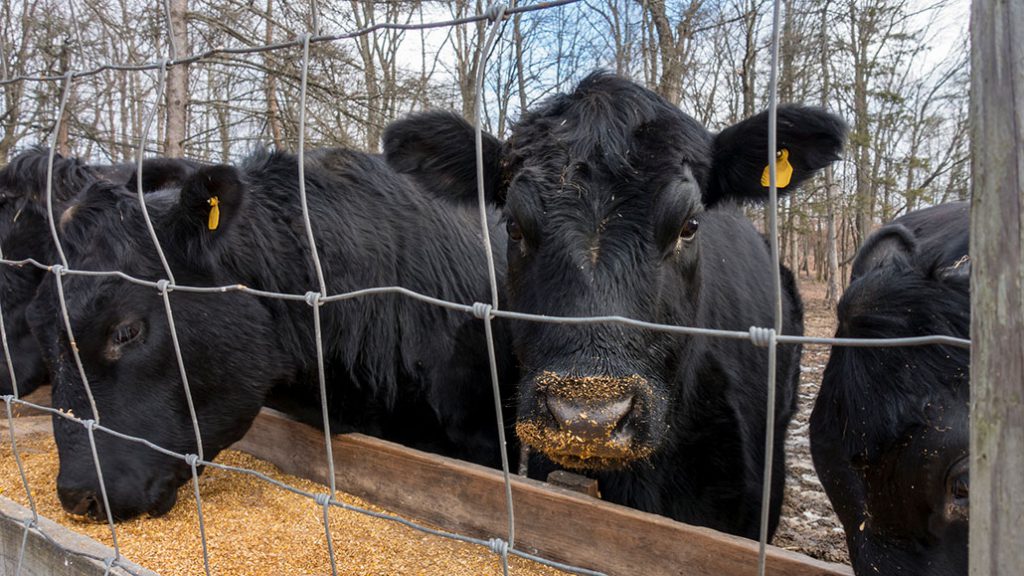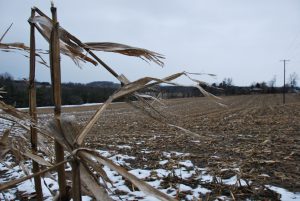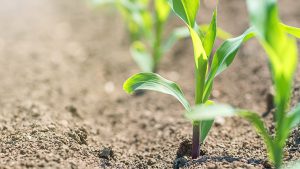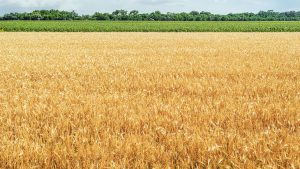Pandemic changes
FEED AND ETHANOL SECTORS RESPOND

THE COVID-19 PANDEMIC has shone a light on the interconnections, vulnerabilities, and resilience within the agriculture and food system. Nowhere is this more evident than in the livestock feed and ethanol sectors — two of the most important domestic markets for Ontario grains.
| WHAT YOU NEED TO KNOW • Dried or wet distillers’ grains are used as an inexpensive but effective feedstuff for livestock. They are a by-product of ethanol production. • One of the biggest challenges was managing ingredient shortages — mainly distillers’ grains. • Before the pandemic hit, an estimated 33 per cent of Ontario’s corn went into ethanol every year. • Early on in the pandemic, Greenfield Global was able to pivot production to make Health Canada approved ethanol for use in hand sanitizers. |
“The price of distillers’ grains more than doubled from the beginning of February to the end of March,” says Jack Chaffe, who has a 3,000 head feedlot operation near Mitchell. He’s also vice president of the Beef Farmers of Ontario.
In normal times, dried or wet distillers’ grains are used as an inexpensive but effective feedstuff for livestock. They are a by-product of ethanol production. When people stopped driving cars and buying gas due to the lockdowns, the market for ethanol contracted severely. As a result, there was a shortage of distillers’ grains, and prices skyrocketed.
Chaffe says he worked with his nutritionist and priced out different options for substituting the energy and protein that the distillers’ grains brought to feed rations. All of them were going to cost a lot more than what he had been paying before the pandemic.
“For the energy, you can just add more corn, but the protein is a bit different — wheat shorts or soybean meal would do, for example,” he says. The problem was that these are by-products as well, and when COVID-19 hit, everything was in short supply.
Chaffe feeds his cattle a wet distillers’ grain called ‘fibre with syrup’ that he buys from IGPC Ethanol in Aylmer.
“We just bit the bullet and paid more for it,” he says, noting that he reduced the amount of the distillers’ grain a little, but didn’t want to risk the cattles’ performance by changing up their rations.
Across the industry, many producers did the same as Chaffe, some made some substitutions such as using urea in the pre-mix. Urea is a non-protein nitrogen source that can partially replace protein in ruminant rations. It is used by the microbes in the rumen to make microbial protein.
“The busiest people were nutritionists for 45 days,” he says. By mid-summer, people were driving again, and the price of distillers’ grains had come down by 40 per cent.
ADJUSTING
“Many of the challenges faced by the feed industry were felt early on, and they did a really good job of adapting and kept feed going to farms,” says Megan Van Schaik, a beef cattle specialist with the Ontario Ministry of Agriculture, Food and Rural Affairs.
One of the biggest challenges was managing ingredient shortages — mainly distillers’ grains, according to Van Schaik, who noted that the feedstuff is used widely across many species.
“Over the years, it’s become a mainstay in rations,” she says, adding that the shortages were felt right across North America.
She says nutritionists looked to other proteins such as soybean meal and canola meal, putting upward price pressure on those ingredients, as well.
“Many cattle feeders looked to urea to control costs,” she says.
The pandemic also presented logistical issues in the feed industry.
“Everybody was feeling the pinch,” says Kevin Weppler, who is general manager at Shur-Gain in St. Marys. “The supply of feed ingredients from offshore was really tight and we had to use up our buffer stock.”
Ingredients such as manganese and amino acids — which ships from China — became scarce. In spite of all the problems, Weppler says his company never ran out.
“You had to be really, really good at procurement — look at what was available, formulate the feed accordingly, and bring the product in as you could.”
“One of the positive things I’d like to say about this whole situation is the open communication that’s occurred throughout the food system,” he says. “People realized that they needed to know what was happening to others up and down the chain.”
He cites the broiler chicken industry, which took a 15 per cent quota cut that affected everyone, from producers to processors to input suppliers (including Shur-Gain). The cut was made in response to reduced demand as a result of the shutdown of hotels, restaurants, and institutions. Weppler says the quota cut is scheduled to be repealed in September.
As to the future, Weppler says that, along with the new normal of physical distancing, masks, and 55 per cent of his people working from home, he is preparing — along with most of the province — for a second wave.
“There are things we can do now to be prepared,” he says, adding that Shur-Gain has a business continuity plan in which they made a number of changes in the first few weeks of the pandemic.
He sees his experience with animal disease outbreaks as a plus for helping with the current pandemic.
“We’ve dealt with avian influenza and Porcine Epidemic Diarrhea (PED) in swine, so we took a lot of lessons from those — especially in terms of biosecurity,” he says.
ETHANOL
Ethanol companies, normally reliable users of Ontario’s corn crop, pulled in their horns and reduced production throughout the province, although there were no plants shut down as happened in the U.S., according to Andrea Kent.
Before the pandemic hit, an estimated 33 per cent of Ontario’s corn went into ethanol every year. However, corn used for ethanol decreased significantly in Ontario, affecting farmers’ ability to sell corn.
Kent, who is the vice president of Government and Public Relations at Greenfield Global, says that demand for gasoline hit its lowest in the U.S. at 50 per cent year over year, which meant hugely reduced demand for ethanol. Similar numbers were experienced in Canada.
“Early on in the pandemic, Greenfield was able to pivot production to make Health Canada approved ethanol for use in hand sanitizers,” she says. Kent credits the federal regulator for quickly implementing a temporary waiver allowing technical grade ethanol to be used in the sanitizers, well ahead of U.S. regulators. In normal times, only food or pharmaceutical grade ethanol is approved for use in hand sanitizers.
Greenfield’s Johnstown plant in eastern Ontario was the first in Canada to supply this ethanol for the hand sanitizing manufacturing market.
“It was great to be able to make a meaningful contribution to the response to the health crisis and keep our plant running,” Kent says. “It’s corn that makes it all possible.”
She says the company relies on a steady supply from local grain farmers to maintain production.
For Greenfield, keeping the lights on at the plants also means being able to continue supplying by-products such as distillers’ grains for livestock feed and carbon dioxide for beverages and refrigeration.
“The whole supply chain benefits from ethanol plants being able to maintain operations,” she says.
Many other ethanol producers and distilleries have subsequently qualified to supply the hand sanitizing markets.
Going forward, Kent highlights the benefits of co-ordination, working together, and the need for meaningful, commercially-driven policies from the government.
She also thinks that demand for cars and gasoline, and by extension ethanol, will increase, as people are allowed to travel more.
“It’s also exciting that Quebec and Ontario are looking at introducing or increasing provincial blending requirements for ethanol in gasoline — which are smart investments both economically and environmentally,” she says.
Kent says that good relationships up and down the supply chain will be needed.
For example, at Greenfield Global, the Buy Direct program enables farmers more access and information throughout the selling process. They can make offers, view discounts, and track contracts, tickets, and payments.
“Everything is real time, online, and available through a smart phone application,” she says. “It makes sense to simplify the relationship between our growers and plant producers and make it work more smoothly.” •





















